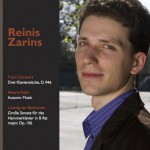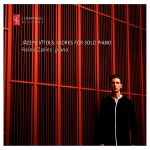CDs
(for REVIEWS see below)

PĒTERIS VASKS. PIANO WORKS (Ondine 2022)
“The Seasons” (1980-2009), “The Cycle” (1976, first recording), “Cuckoo’s Voice” (2021, first recording)
Listen on Spotify, Tidal, appleMusic, amazon music, etc.
 KREISLERIANA. OCTAGON (Skani 2019)
KREISLERIANA. OCTAGON (Skani 2019)
Schumann “Kreisleriana” and Dzenītis “Octagon”
Buy it on Amazon etc, stream it on Spotify and Tidal
LŪCIJA GARŪTA. MUSIC FOR PIANO (Skani 2017)
Piano concerto (Liepāja Symphony orchestra, cond. Atvars Lakstīgala)
Solo piano works
Review see below.
Buy it on Amazon, iTunes, hear it on Spotify
BORN IN 1906. DĀRZIŅŠ. IVANOVS (Skani 2017)
Volfgangs Dārziņš PIANO CONCERTO No.2
Jānis Ivanovs SYMPHONY No.20
Latvian National Symphony orchestra, conductor Andris Poga, soloist Reinis Zariņš
Buy it on Amazon, iTunes, qobuz and elsewhere.
JĀZEPS VĪTOLS: WORKS FOR SOLO PIANO
(Champs Hill Records 2013)
Ten Latvian Folksongs: small paraphrases
Variations on a Latvian folksong
Sonatine
“By the sea”, “Song of the waves”
and other works
Buy it on Amazon, on Bath cds, MDT, Champs Hill
 CIRCUS & MAGIC (Champs Hill Records 2012)
CIRCUS & MAGIC (Champs Hill Records 2012)
Bloch 4 Circus pieces
Debussy Masques, Le Cathedrale engloutie, Feux d’artifice
Ligeti Der Zauberlehrling
Prokofiev Three dances from “Cinderella”
Stravinsky Three movements from “Petrushka”
Buy it on AMAZON UK, HMV or MDT. Stream it free on SPOTIFY (if the link won’t go, just search ‘circus & magic’ on spotify)
 REINIS ZARINS IN WIGMORE HALL LIVE (lemniscat productions 2010)
REINIS ZARINS IN WIGMORE HALL LIVE (lemniscat productions 2010)
Schubert Three piano pieces D946
Vasks Autumn Music
Beethoven Sonata op.106 ‘Hammerklavier’
to purchase please write to zarins.reinis@gmail.com
CD REVIEWS
Review by Claire Jackson (BBC Music Magazine, February 2018):
[Garūta’s] ambitious, creative spirit can be heard in her ravishing Piano Concerto (1952), which reflects the mid-20th century trend of neo-classicism, while the solo part is reminiscent of Tchaikovsky’s concertos — with extra glissandos. [..] Reinis Zariņš zips up and down the keyboard with aplomb while the Liepāja Symphony Orchestra create climactic contours. Garūta’s dualistic style balances darkness and light, and traditional and contemporary melodic ideals. [..] Zariņš mines the music to proffer the listener curious melodic gems. (4 stars)
Review by Stephen Greenbank (Recording of the month, Musicweb-International, December 2017):
[..] Reinis Zariņš’s commanding technique and formidable musicianship are compelling, as is his enthusiastic advocacy of these richly rewarding scores. I was won over by his superb tonal shading and impressionistic colouring. This is what this music needs, and it was served accordingly. The Liepāja Symphony Orchestra under Atvars Lakstīgala provides sensitive support in the Concerto. All of this comes in first class sound and balance. This constitutes a fitting tribute on the 40th anniversary of Lūcija Garūta’s death. (Read more…)
Review by Stephen Greenbank (Musicweb-International, February 2018):
[..] Both works [Dārziņš’s Piano concerto No2 and Ivanovs’ Symphony No20] are ideally served by the deeply committed readings and polished ensemble of the Latvian National Symphony Orchestra, under the inspirational direction of Andris Poga. The pianist Reinis Zariņš not only relishes the Concerto’s generous lyricism, but injects plenty of personality into his playing. This is a rewarding release and earns my enthusiastic thumbs-up. (Read more…)
Review by Steve Arloff (Recording of the month, Musicweb-International, March 2013):
The disc title Circus & Magic is an ingenious way of grouping together this set of short piano pieces. It has allowed for the inclusion of some works that are rarely, if ever heard.
That is certain to be the case with regard to the Bloch pieces which pianist Reinis Zarins writes still remain unpublished 90 years after their composition. On hearing them it is impossible to fathom why that should be as they are truly delightful and beautifully played with perfect timing, pauses all in the right places and plenty of light and shade bringing out the humour which abounds in each of the four character sketches. It’s a shame to bid goodbye to them and move on.
Well that would normally be the case but not so much here as the next works are by Debussy whose music I can never get enough of. Masques is less often heard than other of his piano compositions so it is nice to hear it here. There are some wonderfully delicate moments as well as the a chance to hear the power Debussy brings to his music at times. When I want to buy a new road map I usually look to see if small places that I know are included which are sometimes omitted in some issues; it’s my yardstick for deciding if it is as good as the last one I had. In the same way I regard the way in whichLa Cathédrale Engloutie is played as my benchmark for deciding on a pianist’s Debussian abilities. I agree with Zarins when he writes that it invokes “wondrous amazement in me”. He brings to it that magical mixture of grandeur and mystery with a real sense of an underwater world. Feux D’Artifice is really excellently played achieving the very definition of fireworks with smouldering touch papers followed by some fantastic ‘explosions’. It perfectly encapsulates the images of shooting stars and ends with recognisably dying embers.
The three pieces from “Cinderella” by Prokofiev are again beautifully played, really bringing the magic of his sound-world to life. The Ligeti piece was a revelation to me and I adored it – what a contrast to the hackneyed Dukas; I shall have to look for more of his piano music as I’ve obviously been missing out. It was very interesting to read about how the three movements from Petrushka came about which, along the way, lead to considerable disagreement between Stravinsky and the arrangements’ dedicatee Arthur Rubinstein, about the piano and its role in music. The result in any case was something of such complexity that it was the only work Stravinsky wrote that he himself could not perform. Reinis Zarins, however, makes it sound easy-peasy including the vital contrasting alternation of loud and soft which so often comes with a frequency that must tax the best pianists. The arrangement gives the music a different dimension from its orchestral relation. The result is fabulously exciting with Zarins bringing out every shade of colour and nuance to achieve a brilliant performance of utterly impressive power.
Latvian-born Zarins lives in London with his family so it is to be hoped that we should be hearing a lot more from him which I very much look forward to.
This is a hugely enjoyable disc with a clever and rewarding collection of exciting pianistic gems. I loved it with an hour passing by in what seemed like the blink of an eye. I’m off to play it again … yet again!
Review on ”Expedition Audio”
This new Champs Hill Records release of Jāzeps Vītols’ (1863-1948) piano music will be a welcome discovery for anyone who enjoys exploring the byways of the romantic piano literature. Pianist Reinis Zarins performs a hand-picked selection of pieces made up of miniatures and folksongs as well as the Sonatine Op. 63 in what shapes up to be an ingratiating, fresh-sounding and beautifully performed program. (for full text go to Expedition Audio)
Review by American Record Guide on Vitols Piano works
Educated and later professor at St Petersburg Conservatory, Jazeps Vitols (1863–1948) is regarded as the most important Latvian composer of his generation. Student of Rimsky-Korsakoff, friends with Glazounov and Lyadov, teacher of Prokofieff, his association with an entire era of Russian music was extensive. After the Russian revolution he moved to Riga and founded the Latvian Conservatory. His significance to succeeding generations of Latvian musicians, especially composers, is difficult to overstate.
His music is taut, finely crafted, but alive with humor, lyricism, and expression. Strongly influenced by late-19th-Century developments in both western European and Russian music, his compositional approach involves the combination of folk elements (especially modal harmonies and dance rhythms) with a clear, concise approach to form.
As Latvian pianist Reinis Zarins states in his ‘Foreword’ to the liner notes, “my portrait of Vitols is not chronological and comprehensive; instead, it reveals my preferences for beauty, elegance and humour alongside spirituality and nationalism”. The first selection, 10 Latvian Folksongs: Miniature Paraphrases for Piano, Op 29, offers a charming introduction to Vitols’s sound world. Variously light, noble, jaunty, singing, acrobatic, these miniatures—the shortest lasts 43 seconds, the longest just over 2 minutes—demonstrate the composer’s imagination and versatility as much as his skill and economy. The Variations on a Latvian Folksong, Op 6, an earlier composition, have a more somber, serious tone. The work is more ambitious in scope, lasting over 17 minutes, convincingly crafting a large dramatic arc. Zarins’s playing shines here, demonstrating a sure feeling for the breadth of sound needed to communicate Vitols’s ambitious vision.
The next work thrusts us into the second period of Vitols’s career, when he was living back in Latvia during the period of Latvian independence between the wars. He was by now a firmly established composer, and his style shows a new level of confidence, complete with theatrical hesitations, profound contrasts, and an engaging gestural immediacy. There has been no dramatic alteration in his general musical attitude. Zarins underscores this point by following these selections from Eight Miniatures for Piano, Op 68, with three earlier compositions, including the Waltz-Capriccio, Op 24, a winning showpiece.
The Sonatine, Op 63, returns us to the later Vitols. This three-movement work is the most sophisticated and rhetorically complex piece on the record. Vitols demonstrates taste, mastery, and invention. An important entry in the list of piano compositions written in the 1920s, it deserves to be better known. Three final earlier pieces ease the program to a conclusion—ending with the touching ‘Lullaby’, Op 43:2.
Zarins has chosen good music and ordered it thoughtfully. And he has performed it commandingly and sensitively. It is not difficult to recommend this record to anyone with an interest in the composer, the region, or the period.
— © 2013 American Record Guide
Review by Raymond Beegle (ArkivMusic.com)
A not so clever title, and a photograph of the pianist awkwardly perched on his instrument made me less than hopeful when I pressed the “play” button. However the book turned out to be far superior to its cover. Reinis Zarins is a superb and imaginative musician, an artist with a brilliant technique, and a profound sense of style.
The breadth of tone is so extensive that one has the impression that each set is played on a different piano. Debussy’sCathedrale Engloutie casts a deep spell, and is perhaps my favorite performance next to Paul Badura-Skoda’s (Harmonic Records). Ligeti’s Der Zauberehrling is technically dazzling without taking the focus away from the portrayal of its eerie subject. Prokofiev’s Slow Waltz is played with exquisite tone and grace. The icy and treacherous movements of Petrouchka are delivered with virtuosic assurance. Bloch’s circus portraits were the only pieces that left me unconvinced, but perhaps the composer rather than the pianist is responsible for this.
Review by Michael Church (BBC Music Magazine April 2013)
This variegated collection of works includes a rarity that Reinis Zarins has discovered: Ernest Bloch’s Four circus pieces are not in print, but definitely should be. (..) This 28-year old Latvian has a refined artistry. (..) [His] Ligeti is a delight, beginning in needle-sharp precision and culminating in Mediterranean warmth. Zarins’s Prokofiev is nicely idiomatic and his performance of Petrushka is one of the most charming accounts of this work I have ever heard.


